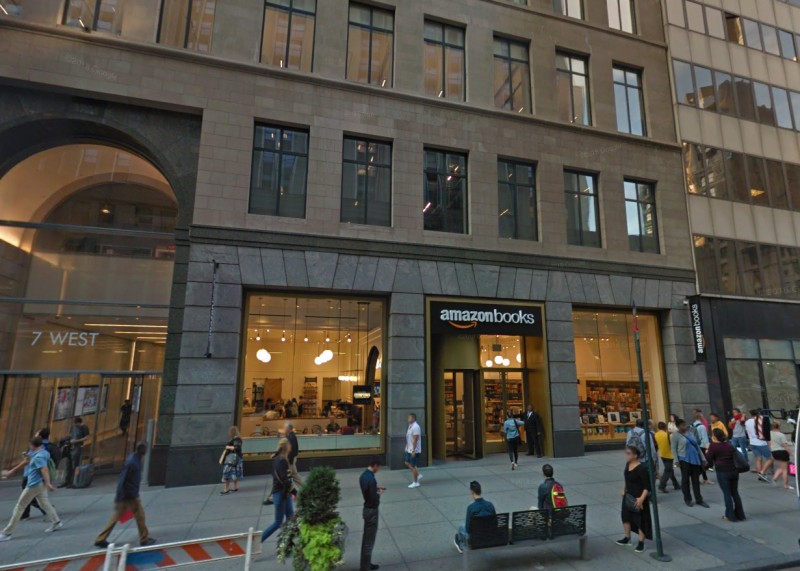Camber Creek’s Jeff Berman on NYC 2030

Amazon Books at 7 West 34th Street (Credit: Google)
By Adam Pincus
PincusCo Media is launching a new series today of Q&As with industry thought leaders who invest, develop, broker or provide professional advice related to New York City real estate. We are asking them questions about what the industry will look like at the start of the next decade.
Jeffrey Berman is co-founder of the Washington, D.C.-based venture capital firm Camber Creek, which has invested in dozens of proptech startups since it was founded in 2011. The firm’s investments include Latch, VTS and Measurabl. A year ago, the company announced it had raised $155 million in its third fund targeting investments in real estate technology. PincusCo conducted this interview through a combination of a Zoom call and emails, and the questions and answers have been edited for clarity.
Do you expect NYC to be larger in 2030?
Yes, I believe New York City will be more populous in the future. So long as any city maintains its economic drivers, all else being equal, that city should continue to grow.
What changes do you expect for buildings themselves?
Buildings will become less static from a use perspective. For example, instead of a building just being used and categorized as office, multifamily or retail, the building’s uses will shift dynamically which means zoning and development will need a rethink. One of our portfolio companies, WhyHotel, is already working on projects where buildings will flex usage.
What changes do you see for how we buy and sell real estate?
A great analog for what the future holds for real estate transactions is the financial services industry; specifically, trading stock. Decades ago, if you wanted to buy or sell shares of stock, you called a broker who called a market-maker who got the order sent to the trading floor where it was executed. Not a seamless or instantaneous process. That changed with the advent of online trading. Now, you can trade in microseconds; this is accomplished by a market mechanism that was developed facilitating instantaneous trading. But if you think about all of the boxes [so to speak] that need to be checked in order for that trade to occur in real time, it’s pretty complex. Especially around the valuation and execution of the trade. Switching gears to real estate, despite the technological tools and advancements available, we have still what remains a very manual workflow between discovery, diligence/appraisal, title search and recordation, loan optimization/selection and execution. There are technology tools that address each of these – like Bowery and Notarize – but they remain siloed. One day they will be integrated and we will be able to trade real estate much in the same way we trade stock.
What will be the impact of that on the value of real estate?
Think about the impact that the creation of REITs had on real estate values (and, by implication, on New York City). It made [commercial real estate] more valuable. Anything that increases liquidity has the potential to increase the value of the asset, because there are more people who can buy and sell.
What do you think about crypto currencies?
It’s still early innings and I personally have not invested in crypto or blockchain technologies. We maintain a watch and wait position.
Where will retail be?
I see retail continue tacking more toward the experiential. As order fulfillment for online purchases gets ever quicker, the necessity for retailers to carry [excess] inventory diminishes. Therefore, store footprints will get smaller and focus on creating the best customer experience possible. As an aside, I recently walked by an Amazon bookstore (in Manhattan). It felt like a Keanu Reeves moment (Whoa!). In all seriousness, Amazon helped hasten the end of the bookstore as we know it. Yet even they’re getting into the IRL retail game to provide customers with a tactile experience.
How will last mile and last block real estate be impacted by changes to retail?
They’re certainly related. As the speed of last mile delivery increases, the necessity for stores to carry [excess] inventory lessens. Somewhat tangentially, I can imagine the day where you walk into a shoe store, try on a “fit pair” for size, customize your item and get it 3D printed in-store. Or maybe 3D printed in a micro warehouse somewhere in the city and ready for delivery in hours or minutes.
What does that do to the net value of retail?
I think high street value will remain – especially in the long term – but footprint and rents will shrink. That is, unless landlords and tenants figure out a way to split proceeds from sales that don’t necessarily happen within the store’s premises (i.e. an evolution of percentage rent).

